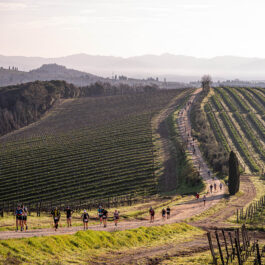A rich cassoulet, served piping hot. If you ask us, no dish better embodies the comfort and warmth we need on a dreary autumn day. We shine a light on this traditional French dish, which in essence is a humble, slow-cooked stew packed with white beans, various meats and pork rinds. But as with many age-old recipes, it’s beloved enough for tensions to run high between localities in its birth area in southwestern France. Let’s dive right in.
The Definition
The basis of cassoulet is a stew of beans, simmered for a long time until they melt in the mouth – arguably, that creaminess of the beans is the secret to a well-made cassoulet. To this stew are added, depending on the version, goose or duck confit, bacon, pork rind, pork knuckle, sausage, mutton or partridge. You can also find versions with tomatoes, celery or carrots. It may or may not be covered in breadcrumbs.

A 2016 article in The New York Post described cassoulet as “the new ramen”, which – cringy hipster vibes aside – isn’t a wholly inaccurate description of the dish’s comfort food credentials. However, “new” it is not by any means. The dish itself predates its current name – in the 17th century it was simply referred to as “estouffat” until it took the name of the glazed, conical earthenware pot in which it is cooked, the “cassole”, in the 18th century.
Cassoulet isn’t particularly hard to make, but it does require one important ingredient that many of us don’t have in abundance: time. A good cassoulet really does take forever. In medieval times, many people’s kitchens (or even their living spaces) were dominated by a large fireplace where, in the morning, they’d hang a big pot, toss in whatever was on hand, and simply forget about it until the evening.
Since then, the French have generally become a bit more particular about their dishes, and current cassoulet recipes contain many codified steps. Chefs swear by using the very best ingredients and don’t even think to cut the tiniest of corners. Haute cuisine versions of cassoulet require simmering the beans with aromatics, and for each meat to be slow-roasted separately.
But truth be told, many French nowadays don’t really get into the trouble of making cassoulet themselves. They eat the stew to their heart’s content at traditional local restaurants or, when cassoulet cravings hit, get some generous scoops from the deli counter at the supermarché. They also see no shame in grabbing a gourmet canned version (we tried and tested them, they’re not half bad).
The Birthplace
According to an 1890 newspaper article in La Revue Méridionale, cassoulet has one specific birthplace: Castelnaudary in southwestern France. This, of course, is hotly debated. “Cassoulet is less a recipe than a way to argue between villages,” said late French chef André Daguin.

[Photo: Jean Luc HEBERT/Flickr]
Legend has it that when, during an English siege of Castelnaudary in the Hundred Year’s War (1337-1453), the people of the town gathered all the available food scraps to make a gigantic stew, or estouffat, to invigorate the combatants. They were then able to drive out the English and liberate the city. While the town indeed suffered greatly during this war, the stew story is most likely the stuff of myths. (It’s also worth noting that the beans used today weren’t introduced to Europe from South America until the 16th century, so if the stew existed at all, it was probably made with fava beans.)
Whether fact or fiction, Castelnaudary has managed to claim the dish. Considering that cassoles were manufactured in the nearby locality of Issel, excellent lingot beans grew in the area and, in 1836, the first cassoulet factory opened its doors – the case for Castelnaudary as “the birthplace of cassoulet” does seem quite plausible.
In fact, there’s even a society called La Grande Confrérie du Cassoulet de Castelnaudary (The Grand Brotherhood of Cassoulet from Castelnaudary) whose whole raison d’être is to promote and defend the pride of Castelnaudary. And each year, the town celebrates the Fête du Cassoulet with free concerts, a flower parade, entertainment and, of course, generous amounts of piping hot stew.
The Variations
One will find many renditions of cassoulet throughout France, but three such variations have come out on top as the most famous, each vying for its place in culinary history – and for status as the best-tasting recipe.
Castelnaudary cassoulet contains goose confit, pork shank or shoulder, sausage and pork rind. A poultry carcass or a few bones of pork, onions and carrots are also used to prepare the broth that serves as the base of the dish, however they are not present in the final product.
Carcassonne cassoulet may contain partridge instead of duck, as well as a piece of mutton.
Toulouse cassoulet has duck or goose confit and Toulouse sausage, carrot and onion studded with cloves. It is sometimes covered with breadcrumbs before it is put in the oven.
Make It Yourself
If you ever attempt to have a go at making your own cassoulet, hats off to you. If you don’t have the clay pot – the preferred cooking vessel, as it allows for even heat distribution – we recommend using a Dutch oven that can go from the stovetop into the oven.
Shortcut recipes do exist (just don’t tell the French). Food writer Mark Bittman’s version of a crock pot cassoulet doesn’t have a thousand steps, but is quite tasty.
Whatever recipe you choose, be sure to make a large enough amount to justify going through all the trouble of sourcing and preparing your ingredients. The flavours always intensify and invariably improve over the next few days. The dish also freezes well, so you’ll always have ultimate comfort food close at hand.
Wash It Down
Obviously you can’t serve a French dish of this kind without wine. Impossible! Choose a robust, southern French red that can stand up to the richness and intensity of flavours in the dish. Opt for a Madiran or a Cahors if you can find one.
The Recipe
You could try Julia Child’s version (above), or attempt the one below, adapted from the official Castelnaudary recipe.
Ingredients:
350g to 400g dried white beans (lingot type)
2 duck or goose confit, cut in half (keep the fat)
4 80g pork sausages
4 pieces of 50g pork meat taken from the shank, shoulder or breast
250g pork rind (half of which will be used after cooking for the assembly of the cassoulet)
A little salted lard
1 chicken carcass or a few pork bones
Onions and carrots
3-4 garlic cloves
Method:
The day before:
Soak the beans overnight in cold water.
The morning of:
1. Drain the water and add the beans to a saucepan with three litres of cold water, and boil for five minutes. Turn off the heat, drain the water and reserve the beans.
2. Proceed with the preparation of the broth with another three litres of water, the rinds cut into wide strips, a poultry carcass (if you have it) or a few pork bones and, according to your taste, some onions and carrots. Generously season with salt and pepper. Simmer the broth for one hour, then strain it and collect the rinds.
3. Cook the beans in this filtered broth until they are soft but remain whole, around one hour.
While the beans are cooking, prepare the meats:
1. In a large sauté pan, degrease the pieces of confit over low heat then set aside.
2. In the remaining fat, brown the Toulouse sausages, then set them aside.
3. Brown the pieces of pork to a golden-brown and reserve them with the other meats.
4. Drain the beans and keep the broth warm. Add a few cloves of garlic to the beans along with the lard, crushed together.
Assembling the cassoulet:
Use a cassole if you have one, otherwise a fairly deep terracotta dish suitable for the oven will do.
1. Line the bottom of the dishe with pieces of rind, then add about a third of the beans. Arrange the meats and pour over the remaining two thirds of the beans.
2. Arrange the sausages by pushing them into the beans with the tops of the sausages remaining visible.
3. Complete the dish by adding some of the broth which should just cover the beans. Make sure to keep some of the broth!
4. Sprinkle pepper on the surface and add a tablespoon of the duck fat used to brown the meat.
Cooking:
1. Place the cassole in an oven preheated to 160°C and cook for two to three hours.
During cooking, a golden-brown crust will form on the top of the cassole, which will have to be pushed back into the stew several times (they used to say 7 times).
2. When the top of the beans begins to dry, add a few spoonfuls of broth.
3. Serve piping hot with bread and red wine.














Sorry, the comment form is closed at this time.